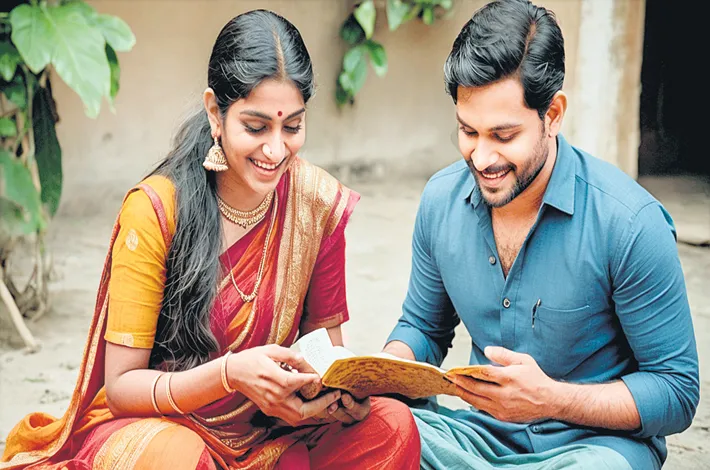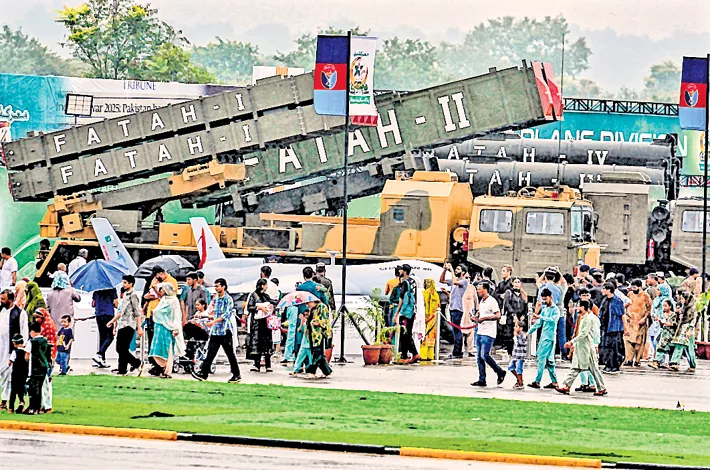The Loom of Love
16-06-2025 12:00:00 AM

One evening, as the sky burned orange over the Deccan plateau, Ravi asked Anjali to show him the town. She hesitated, aware of the whispers that followed a young woman walking with an outsider. But something in Ravi’s earnest gaze convinced her. They wandered through Narayanpet’s lanes, past the ancient Hanuman temple where devotees chanted, and along the banks of the Bhima River, where the water shimmered under the fading light
In the heart of Narayanpet, a small town in Telangana known for its vibrant handwoven sarees, the air was thick with the scent of jasmine and the rhythmic clack of looms. It was here, under the relentless sun of a late summer afternoon in 2025, that Anjali first saw Ravi.
Anjali, a 24-year-old weaver’s daughter, had grown up threading silk through the warp and weft of her father’s loom. Her hands, calloused yet delicate, moved with the grace of a dancer as she wove intricate patterns into Narayanpet sarees, each thread telling a story of tradition. Her life was simple, tethered to the loom and the small courtyard of her mud-walled home, where marigold flowers bloomed in defiance of the arid soil.
Ravi, a city-bred photographer, had come to Narayanpet on assignment for a magazine, tasked with capturing the essence of its textile heritage. His camera hung around his neck like a talisman, and his eyes, sharp and curious, scanned the bustling market for a story. It was in the narrow lanes, lined with shops selling sarees in hues of turmeric and crimson, that he first glimpsed Anjali. She sat cross-legged at her loom, her fingers coaxing a pattern of paisleys into existence, her brow furrowed in concentration. The sunlight caught the gold thread in her work, and for a moment, Ravi forgot to breathe.
He approached her cautiously, his city accent softening as he asked, “May I take a picture of you weaving?” Anjali looked up, her dark eyes wary but intrigued. She nodded, a small smile breaking through her reserve. The shutter clicked, freezing her in a moment of quiet artistry. That photograph would later grace the magazine’s cover, but for Ravi, it was the beginning of something far more personal.
Over the next few days, Ravi found excuses to return to Anjali’s street. He’d linger near her loom, asking questions about the weaving process, though his eyes were more interested in the curve of her smile than the mechanics of her craft. Anjali, initially shy, began to open up. She spoke of the lore behind each design—the peacocks symbolizing grace, the lotuses for purity—and Ravi listened, captivated not just by her words but by the passion in her voice.
One evening, as the sky burned orange over the Deccan plateau, Ravi asked Anjali to show him the town. She hesitated, aware of the whispers that followed a young woman walking with an outsider. But something in Ravi’s earnest gaze convinced her. They wandered through Narayanpet’s lanes, past the ancient Hanuman temple where devotees chanted, and along the banks of the Bhima River, where the water shimmered under the fading light. Anjali pointed out the banyan tree where her grandmother used to tell her stories, and Ravi shared tales of his life in Hyderabad, a world of glass towers and endless noise that felt alien to her.
As days turned into weeks, their meetings became a quiet ritual. Ravi would bring her small gifts—a packet of chai masala, a book of poetry—and Anjali would teach him to thread a loom, laughing when his clumsy fingers tangled the silk. Their conversations wove a delicate thread between their worlds, fragile yet vibrant like the sarees she crafted. But love, like a loom, requires tension to create beauty, and tension was brewing.
Anjali’s father, Venkatesh, noticed the way his daughter’s eyes lit up when Ravi’s name was mentioned. A traditional man, he dreamed of a groom from their community, someone who understood the rhythm of their life. “He’s a city boy,” Venkatesh warned Anjali one evening, his voice heavy with concern. “His world is not ours.” Anjali’s heart sank, but she couldn’t deny the truth in his words. Ravi’s life was transient, tethered to assignments that could take him anywhere, while hers was rooted in the red earth of Narayanpet.
Ravi, too, sensed the growing distance. He saw it in the way Anjali avoided his gaze when he spoke of the future, in the hesitant pauses that crept into their conversations. One night, under the same banyan tree where Anjali had shared her childhood stories, he took her hand. “I don’t want to leave without you,” he said, his voice raw. Anjali’s eyes glistened, but she pulled her hand away. “This is my home, Ravi. My loom, my people. I can’t leave them.”
The next day, Ravi’s assignment ended. He packed his camera, his heart heavy with the weight of unspoken words. Before leaving, he visited Anjali one last time. She was weaving, her hands steady despite the tears she hid. He placed a small package beside her—a photograph of her at the loom, framed in teak, with a note: “Your art is your soul, and I’ll carry it with me always.”
Months passed. Anjali poured her longing into her sarees, each design more intricate than the last. Her father noticed the change, the way her work now carried a depth that spoke of love and loss. One day, a letter arrived, postmarked from Hyderabad. Inside was a clipping from a national exhibition catalog, featuring Anjali’s sarees. Ravi had submitted her work, and now galleries across India wanted her designs. With the clipping was a note: “Your art deserves the world. I’m just helping it get there.”
Anjali smiled, her heart threading a new pattern—one of hope. She didn’t know if she’d see Ravi again, but she knew their story wasn’t over. In Narayanpet, where every saree told a tale, hers was just beginning.








